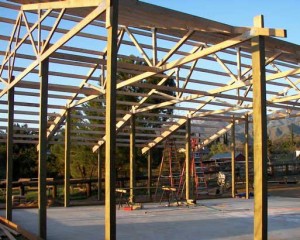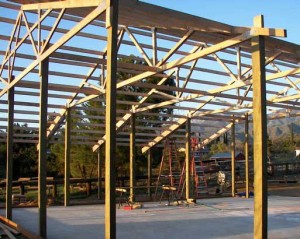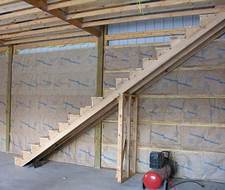This is a product review for Tuff Posts, a product I have never used. Now how can I feel qualified to do such a review? Thanks to the miracle of the internet, a plethora of information can be gleaned on nearly any product.
Tuff Posts are prefabricated columns for use in pole buildings. As a three-ply 2×6, the bases are composed of pressure treated members six, eight and 10 feet in length. The long 10 foot member is in the center. Four ply 2×6 columns use eight, 12, six and 10 foot members, in this order.
All of the lumber used in Tuff Posts is #2 grade Southern Yellow Pine (SYP), which has a base fiber stress in bending (Fb) value of 1000 pounds per square inch (psi). Because three or more members are utilized in the unit, an increase in the design fiber stress for repetitive members (Cr) of 15% is allowed. This gives a design value of 1150 psi.
The base members are pressure preservative treated with Chromated Copper Arsenate (CCA), which (in my humble opinion) is a perfectly fine product – however has been deemed inappropriate for use in certain instances (which include residential construction). With a treatment level of .60 (6/10 of a pound of treatment chemicals minimum added per cubic foot of lumber), they meet the requirements for UC-4B (structural in ground use).
Upper portions of the tuff post columns are untreated, and are placed square ended above the lowers. The members are glued and hydraulically pressed together, then mechanically nailed. After the fastening process is complete, the post is planed on both faces.
Now…the downsides…
Tuff Posts are not true glu-laminated columns. If they were, the uppers and lowers would be joined together in a glued finger jointed splice and there would be no need for nails to be used to connect the members. I surmise the glue being used is merely a construction adhesive, rather than a resorcinol, or similar, glue which is typically used for glu-lams.
 In my opinion, the weak link is the splice. With the nails having to do the work, and twice as many nails into the center member of the three ply unit – my educated guess is (if tested to failure in laboratory conditions) the center member is going to fail nearly every time. Having been involved personally in testing similar columns at the Forest Products lab at Oregon State University, the results are perhaps not quite as optimistic as the product manufacturer might suggest.
In my opinion, the weak link is the splice. With the nails having to do the work, and twice as many nails into the center member of the three ply unit – my educated guess is (if tested to failure in laboratory conditions) the center member is going to fail nearly every time. Having been involved personally in testing similar columns at the Forest Products lab at Oregon State University, the results are perhaps not quite as optimistic as the product manufacturer might suggest.
My recommendation – solid sawn or true glu-lam columns will provide design solutions without the questions which arise from the type of joint found in Tuff Posts. If looking for a high strength to weight product, then the investment in true glu-lams is most likely the answer.









